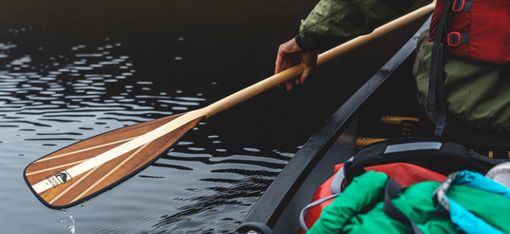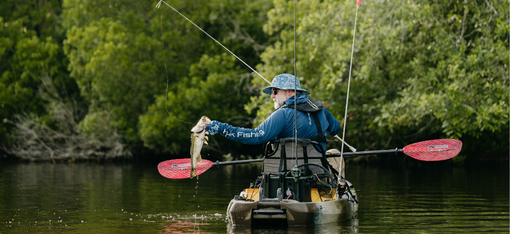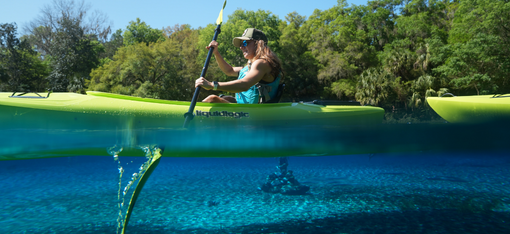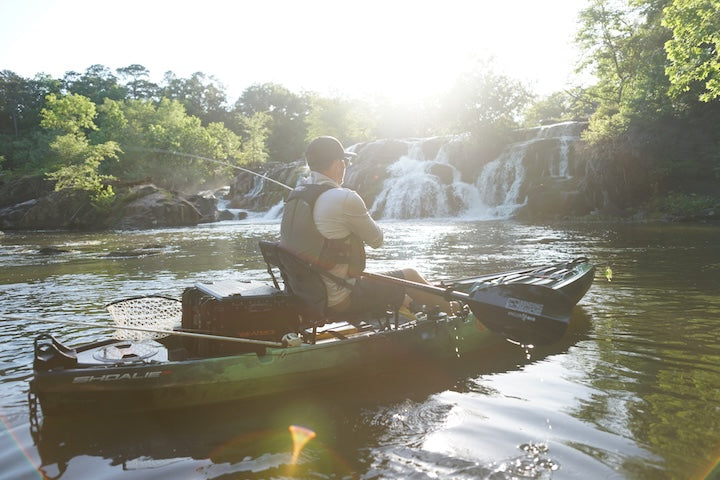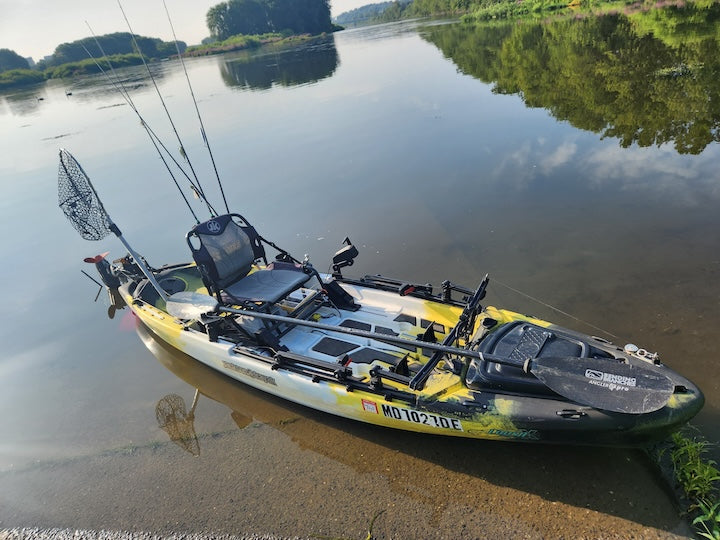The Golden Rules of Portage Etiquette
7-minute read
By Mikaela Ferguson

Understand the Golden Rules of Portage Etiquette before your canoe camping trips this summer (photo courtesy of Andrew Strain)
As with the last two summers, this year we can expect another season of increased interest in canoe camping. Unless you’re planning a trip in the middle of nowhere, it’s less likely you’ll find yourself completely alone on your canoe trip.
Usually, passing other groups while canoeing is a low-key, refreshing experience. Maybe you share some know-how about the campsites on the next lake or you talk about a brutal portage from the day before.
But when you pass other groups while on the portage, it can be a little trickier. Put-ins and take-outs can be small, so there’s a limited number of canoes that can be pulled up. Portage trails tend to be narrow, and can have thick forest on either side, making it difficult to pass others.
As such, it’s not uncommon to encounter ‘traffic jams’ at portage trails, especially on popular routes or on the weekend.
But encountering others on the portage trail doesn’t have to be problematic. If everyone is familiar with the golden rules of portage etiquette, it’s easy to get through any portage without incident.
Below I’ve highlighted the golden rules of portage etiquette. If everyone follows these rules, we’ll all have a much better experience portaging!
Please note: This post only goes over tips for having good portage etiquette. If you’re looking for tips on making portaging easier, read this post.
At the Start: Move Your Gear to the Side
As soon as you reach the start of the portage trail, move your boats and gear to one side of the take-out. You want to ensure there is sufficient room for another group to comfortably unload if they pull up shortly after you.
Note: Please keep your canoes and gear to one side of the take-out, not both sides.
Try to keep all of your gear as compact as possible. Avoid ‘yard sale-ing’, which is the act of tossing bits of gear all over the place and taking up a ton of space. Not only does this cut down on the space available for another group, but it increases the chance someone will step on your stuff or you’ll forget a piece of gear.
While Portaging: Yield to the Canoe
This should be obvious, but if you encounter another person on the portage trail you should always yield to the person carrying the heaviest, most awkward item.
This means the person carrying a canoe has the right of way. Always.
If you’re carrying a pack or a barrel and you see someone approaching with a canoe, get off the trail! We do this for two reasons:
- It is tough to see the trail while carrying a canoe. The person carrying the canoe may not see you right away. You’ll likely see the canoe before it sees you, so you have more time to safely step off the trail and let them pass.
- Carrying a canoe is super awkward! The last thing the canoe-carrier wants is to stop/slow down/move off the trail while carrying a 17 ft, 60 lb piece of plastic. It’s way easier to step aside when all you have is a pack or barrel and some paddles.
If the two people approaching one another both have a canoe, well that’s just bad timing. Typically, the person who sees the other person first will move to the side.

Portaging across rocky riverside terrain
While Portaging: Let Faster Portagers Pass You
Likewise, be aware of the portage trail behind you, as someone from your group or another group may be approaching and want to pass you.
In this case, step to the side and let people pass you as soon as it’s safe to do so (unless you’re carrying a canoe). It can be really frustrating when you’re carrying something heavy and get stuck behind someone slower than you. If you’re the slow one, move to the side.
Note: That doesn’t mean fast portagers should be tailgating or rude to the person in front of them. Maybe they didn’t hear you and don’t know you’re behind them. Call out a friendly “Behind you!” to let them know you’d like to pass.
That said, if you’re the one carrying the canoe, you do not need to step off the trail or put the canoe down to let someone pass. Canoes always have right of way. The person behind you can take a break and let you get ahead before continuing.
This may sound like a lot of rules, but it comes down to this basic principle: Be Kind to People Carrying Canoes.
It’s that simple. Some people are skilled and experienced canoe carriers and don’t mind it. But for a lot of people (myself included), carrying a canoe is not fun. Do whatever you can to make this person’s life better.

When carrying a barrel or pack, be sure to move off the portage trail when a canoe is coming
While Portaging: Be Mindful Taking Breaks Mid-Portage
Sometimes you need to take a break in the middle of the portage. There is absolutely nothing wrong with that.
But you need to stay mindful of your surroundings. If you see someone approaching in either direction, ensure you and your gear can be fully off the trail, giving the portager a clear pathway to pass you.
Sometimes portages can be really long, and it makes sense to take group breaks partway down the trail. Again, that is totally okay. But you need to consider what’s going on around you. If you’re on a popular route on a Saturday and there are lots of people on the portage, don’t take long, group breaks in the middle of the trail.
But if you’re on a lesser-travelled route and likely won’t see anyone else, take a break in the middle of the trail. Just pay attention and, if someone does approach you, ensure everyone and all their gear can quickly clear the trail for the other people.
At the End: Leave Room for Other Boats at the Put In
Similar to what you should do when you unload your boats, please leave room for other people to use the portage put-in while you’re loading your boats.
If you need to make two trips, keep your boats and gear off to the side while completing the second trip. This way, other people can easily load/unload their gear at the put-in while you’re off grabbing the rest of your gear.
Once you’re ready to load everything and take off, avoid taking up the entire put-in. That said, sometimes put-ins are narrow and awkward, and you can’t help but take up all the space.
In that case, try to be speedy. Load your boats, push off and be on your way. Don’t start loading your boats, take a break to take photos, eat a snack and then push off. Someone else may want to use the put-in at the same time.

Portage put ins and take outs can be narrow, be sure to move your gear to one side
At the End: Have Someone Sweep the Portage
The last person in your group to walk the portage is responsible for sweeping the portage trail.
What does ‘sweeping’ mean?
Sweeping means scanning the take-out, portage trail and put-in for any gear or garbage that has been dropped or forgotten. The sweeper is responsible for ensuring all of the gear that arrived at the portage makes it into the boats on the other side, and that no garbage is left at the portage (#leavenotrace).
Now, accidents happen and every once and a while, someone forgets something at a portage. If you do stumble across a forgotten item, like a water bottle, sweater or paddle, place it somewhere obvious along the portage trail. The person to whom it belongs may be coming back for it.
While you’re sweeping, I encourage you to pick up any garbage you see along the trail (even if it’s not yours, but assuming it’s safe to do so). I know it’s annoying (why should you have to pick up someone else’s trash!). But these small acts help keep our parks and public land clean, healthy and safe.
The Entire Time: Say Hi and Be Kind
Throughout the entire portage experience, be friendly and considerate to the people around you. If you encounter another group at the take-out or put-in, say hello. Ask them about how their trip is going.
When someone lets you pass them on the portage trail, say thank you.
If someone is struggling with a piece of gear or there is a section of the portage with tricky footing, offer to help (just don’t be arrogant or condescending about it).
As always, have fun, be safe, and happy paddling!
Mikaela is the voice behind Voyageur Tripper, an outdoor blog that aims to teach people how to take longer and more challenging trips in the backcountry. She previously worked as a wilderness guide, leading canoeing and hiking trips in Ontario, Quebec and Nunavut. Mikaela currently lives on the West Coast. You can find her on Instagram at @voyageurtripper.

Do you have paddle questions our friendly Customer Service Team can help you with today? Contact them: 715-755-3405 • [email protected]
More for you...




